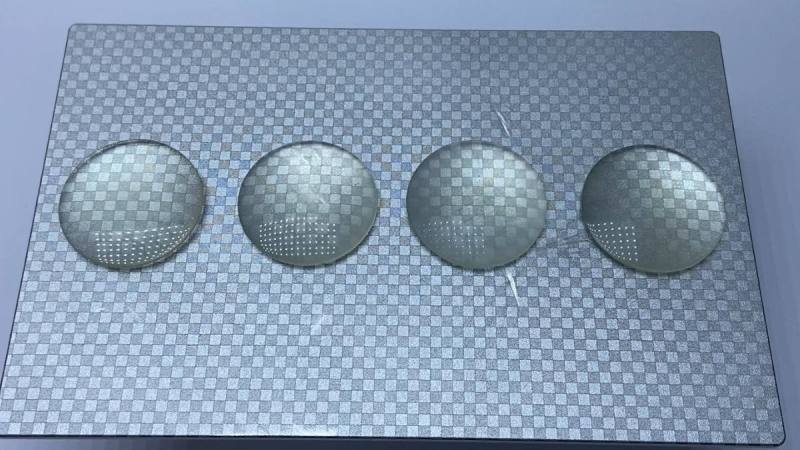When one thinks of applications for 3D printing, optical components don’t seem to be a good fit. With the possible exception of Fresnel lenses, FDM printing doesn’t seem up to the job of getting the smooth surfaces and precision dimensions needed to focus light. Resin printing might be a little closer to the mark, but there’s still a long way to go between a printed blank and a finished lens.
That gap is what [Fraens] aims to fill with this homebrew lens grinding machine. It uses the same basic methods used to grind and polish lenses for centuries, only with printed components and lens blanks. The machine itself consists of a motorized chuck for holding the lens blank, plus an articulated arm to hold the polishing tool. The tool arm has an eccentric drive that wobbles the polishing tool back and forth across the blank while it rotates in the chuck. Lens grinding requires a lot of water and abrasive, so a large bowl is provided to catch the swarf and keep the work area clean.
Lens blanks are printed to approximately their finished dimensions using clear resin in an SLA printer. [Fraens] spent a lot of time optimizing the printing geometry to minimize the number of print layers required. He found that a 30° angle between the lens and the resin pool worked best, resulting in the clearest blanks. To polish the rough blanks, a lapping tool is made from polymer modeling clay; after baking it dry, the tool can hold a variety of pads and polishing compounds. From there it’s just a matter of running the blank through a range of abrasives to get the desired final surface.
Are the lenses fantastic? Well, they’re probably not going to make it into fine optical equipment, but they’re a lot better than you might expect. Of course, there’s plenty of room for improvement; better resins might result in clearer blanks, and perhaps degassing the uncured resin under vacuum might help with bubbles. Skipping the printed blanks and going with CNC-machined acrylic might be worth a try, too.

















Fantastic project! Does anyone have an idea how I can make real glass for lenses? I have access to furnaces and various related equipment.
Check out the “How to Make Everything” YouTube channel.
For optical lenses, you’ll want to start with “crown glass”… Actually fairly easy to make, compared to other glasses… not to say EASY to make. Getting an optical quality gather and blow of crown glass is a whole different matter that takes years of practice. Since you “have access to furnaces and related equipment” I will guess you are somewhere with a glass blowing shop. The instructor or master glassblower would be the place to start with your questions.
Second suggestion would be to talk to your local optometrist/optician. There are still companies making glass lens blanks for spectacles, and you can possibly have them order a couple blanks for you.
Third, grinding glass lenses take a LOT more work, a LOT more time, and completely different abrasive setup, than a resin or other plastic lens. Orders of magnitude more. And then you still have the hardening and tempering stages to deal with, so that there is SOME factor of safety in the new lens. Probably want to start practicing on some cheap plate glass (soda-lime float glass) just to see if your patience, grinding equipment and skills are up to the task, in much the same way jewelers practice in copper and brass before moving on to making stuff in silver and gold. All the same techniques and skill are used, but if you screw up it’s MUCH less expensive of a mistake.
Next up, at-home eye surgery.
At-home Lasik would just need the right G-code for your laser cutter, right?
As I loved to tell programmers, ‘it’s just software, right?’
I love that phrase. It’s like I tell the mechanics, “It’s just a transmission, right?”
I’ve been meaning to get Lasik. Can someone point me to an open source project on GitHub or somewhere?
Looks like a lens polisher–not a lens grinder.
What’s the difference between polishing and grinding? Surely just scale? Remove millimeter size bits of glass, and it’s grinding; remove nanometer sized bits, and it’s polishing. If bacteria were doing the job, it would always be grinding, or maybe civil/earthworks at first.
The amount of media removed and the change in the profile. In polishing the profile is already set. The machine just follows the surface. In grinding a whole new profile is created.
In the optical laboratory, the exact same machine is used for the grinding and polishing… just one uses abrasive pads and water, the other uses felt pads and liquid polish. Mechanically, the machines are identical though.
Hm. Perhaps it’s possible to 3D print a pair of glasses?
You wouldn’t steal a pair of glasses.
* “You wouldn’t download a pair of glasses.”
But would you download a glass pears?
As long as you don’t want to eat the pears
What’s the “possible exception” for Fresnel lenses? Is this a callback to that dreadful story a few months back that seemed to equate “Fresnel lens” with “anything that’s flat, clear, and has concentric ridges”?
I just hope he doesn’t fall into the grinder, he could make a spectacle or himself. I’ll show myself out.
I wonder if water glass can 3D printed into lenses.